Abstract
Articular cartilage repair was followed for one year in skeletally mature dogs after destabilisation by anterior cruciate ligament transection of the stifle joint (CT), abrasion of the inferior medial condyle (ABR) to bleeding bone, or anterior cruciate transection followed by chondral abrasion (CT/ABR). ABR animals formed repair cartilage at the abrasion site (ABR and CT/ABR) at six months as determined by arthroscopy and at necropsy. CT and CT/ABR animals had an additional cartilage ulcer on the superior aspect of the medial condyle. The abraded site extended in CT/ABR condyles. Repair cartilage (ABR and CT/ABR) contained reduced amounts of proteoglycan as seen by histological loss of safranin O staining and reduced uronic acid content. Fibrocartilage was suggested by histological appearance, hypocellularity, and a higher hydroxyproline content. In contrast with ABR animals, the repair cartilage in the CT/ABR animals contained near normal amounts of hydroxyproline. Collagen profiles of abrasion site repair cartilage in ABR animals had more types I and V collagens, similar amounts of type VI collagen, and decreased amounts of types II, IX, and XI collagens than CT/ABR animals. The results of this study are consistent with abrasion chondroplasty leading to a repair cartilage. Despite extended ulcers, repair cartilage from the destabilised joint (CT/ABR) animals was more hyaline-like in its hydroxyproline content and collagen composition than repair cartilage from the stable joint (ABR animals). In these models additional measures appear to be needed as the defects induced by abrasion chondroplasty did not form a functional hyaline cartilage.
Full text
PDF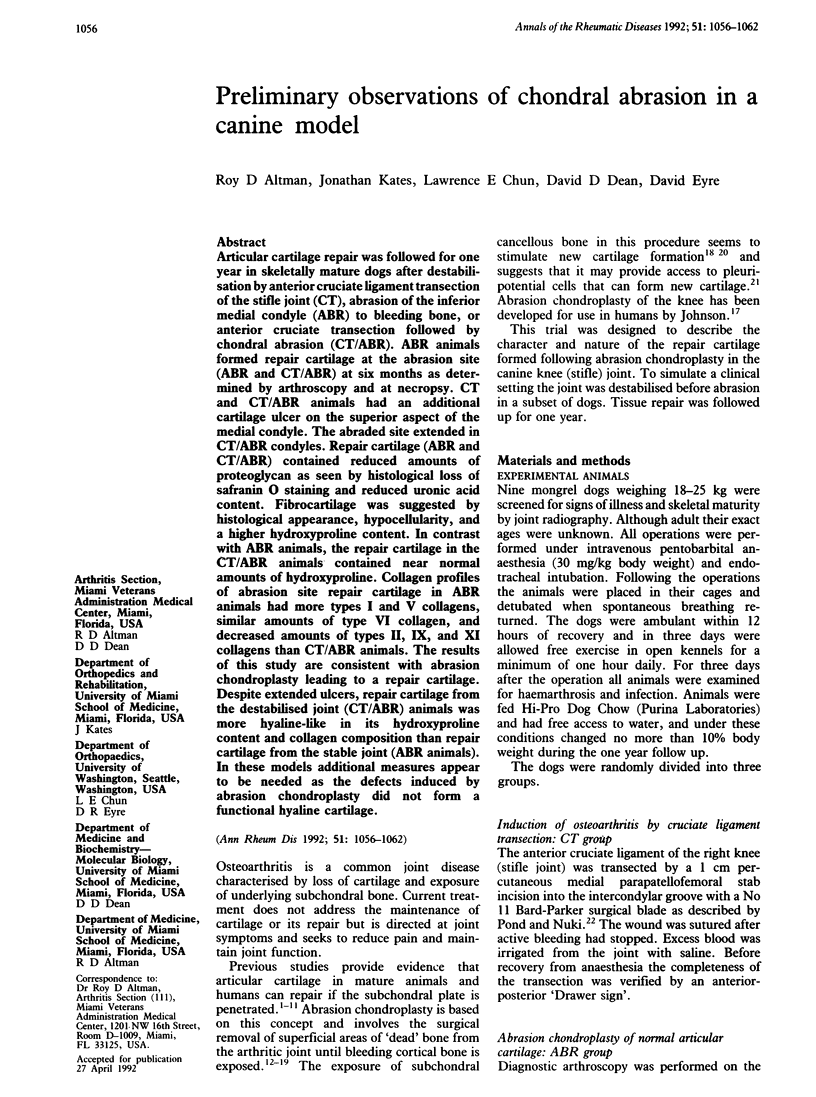
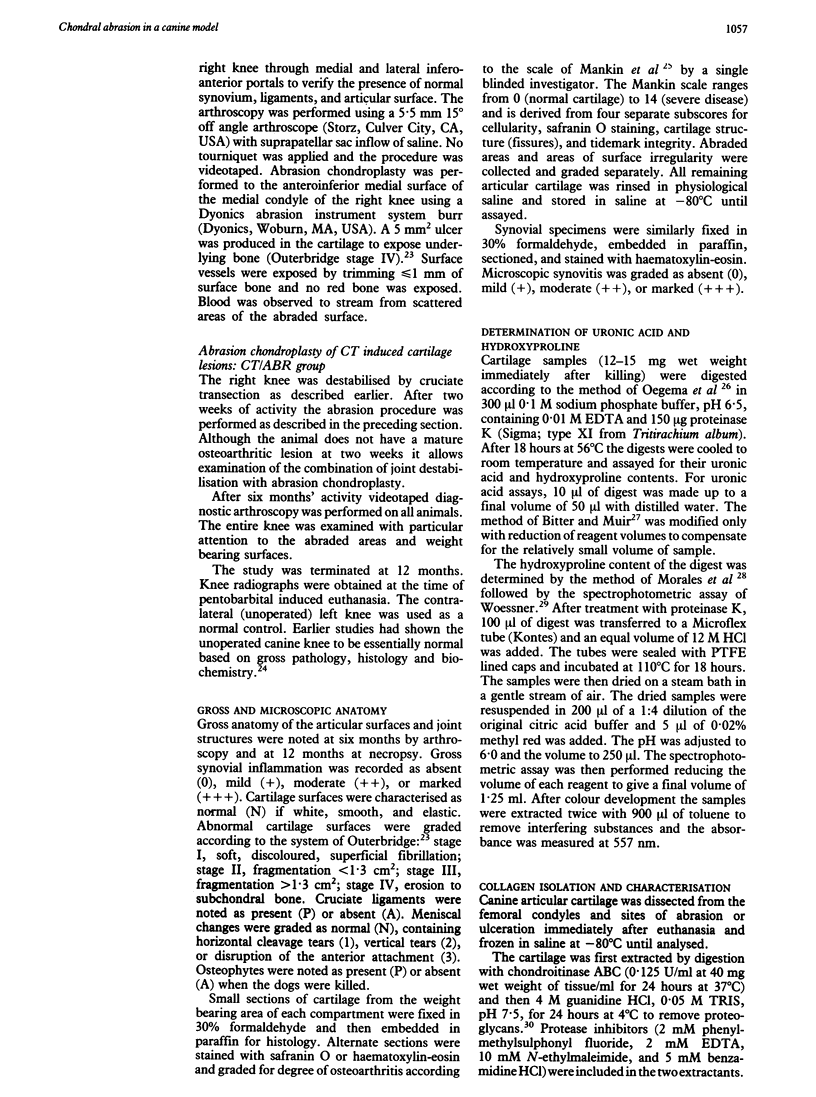
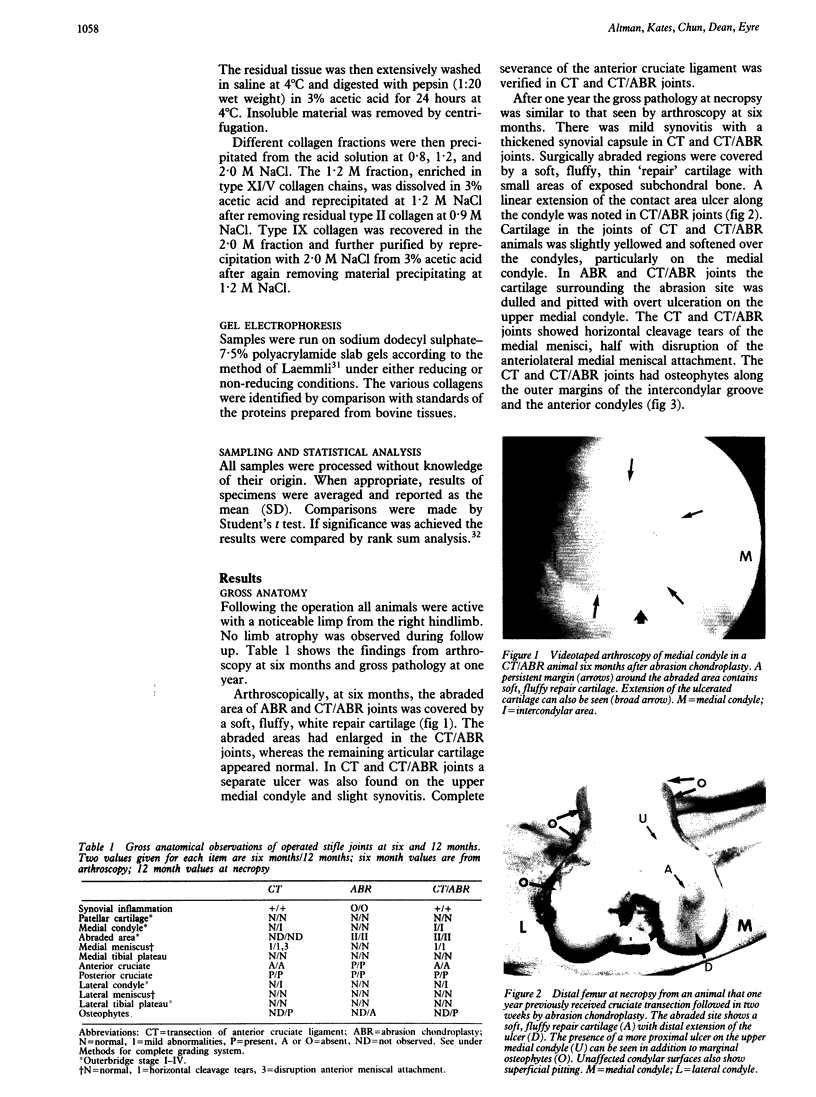
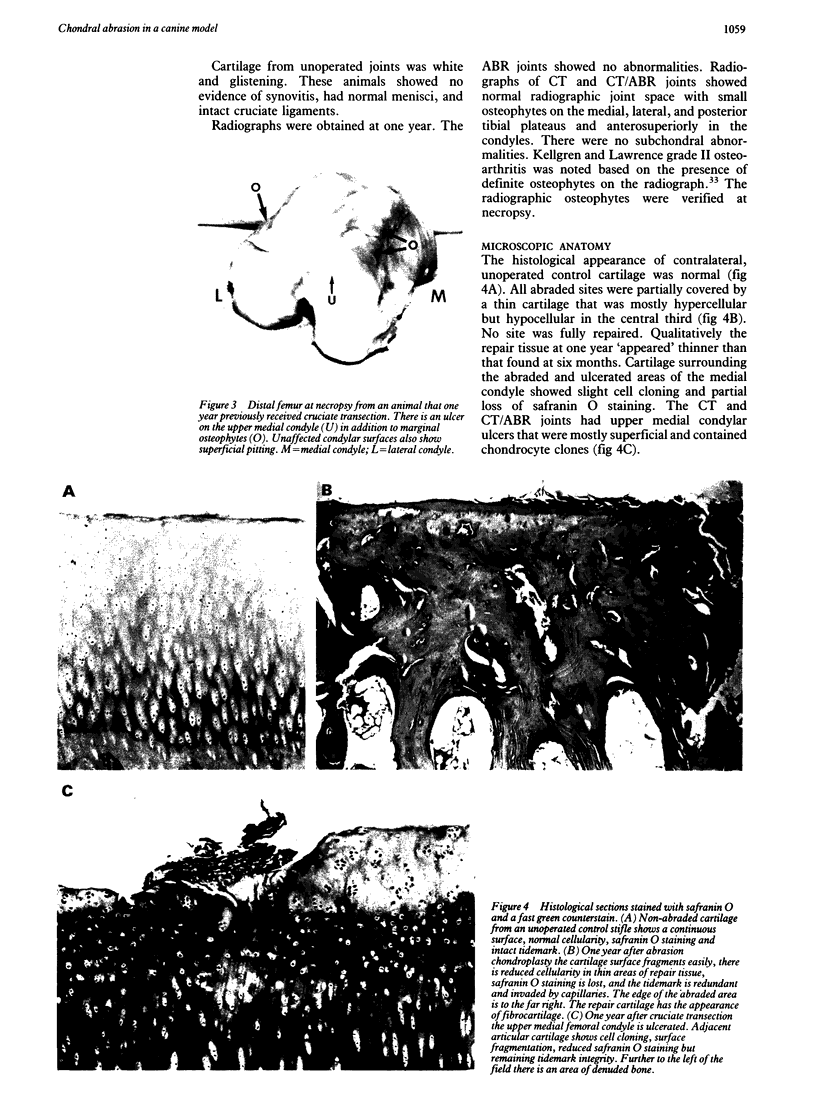
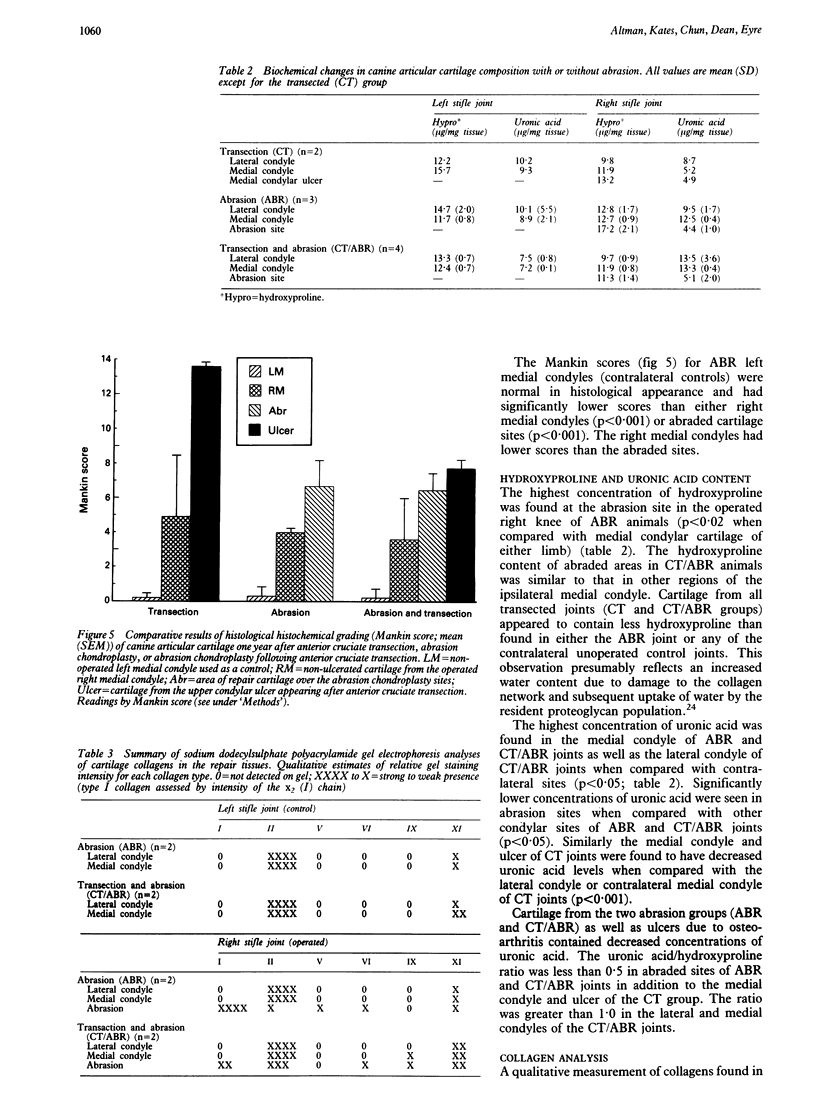
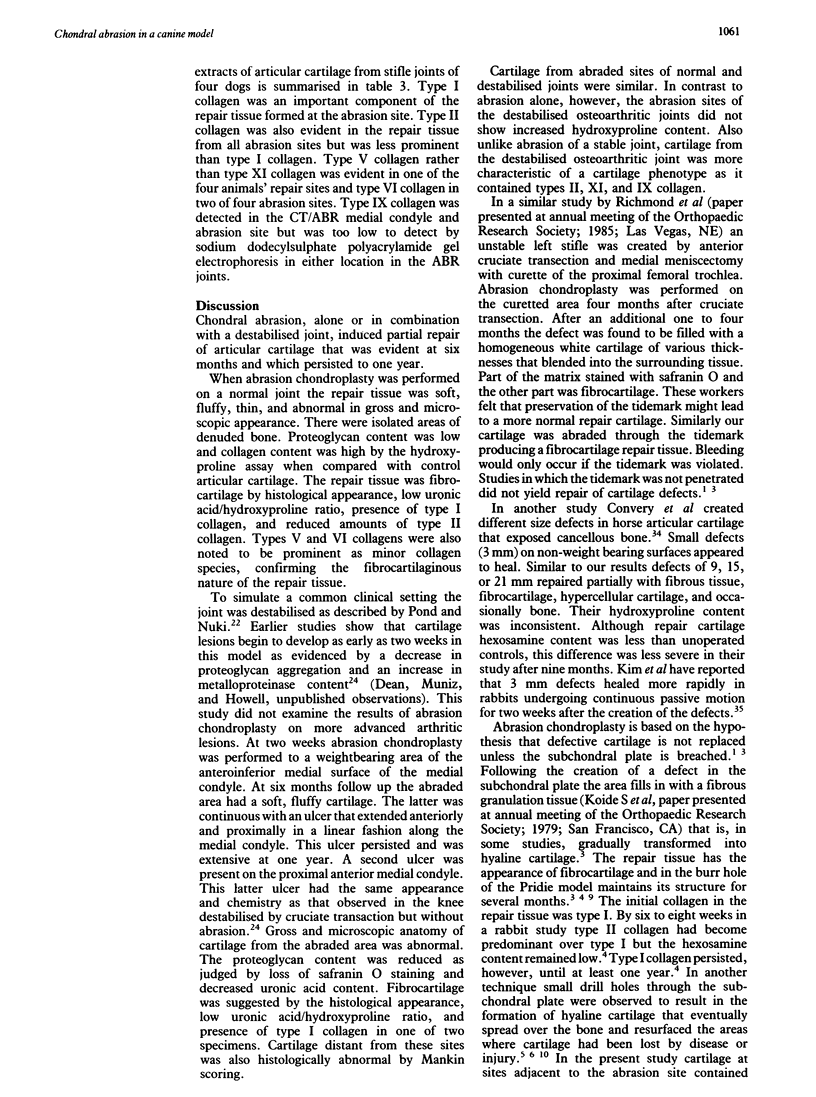
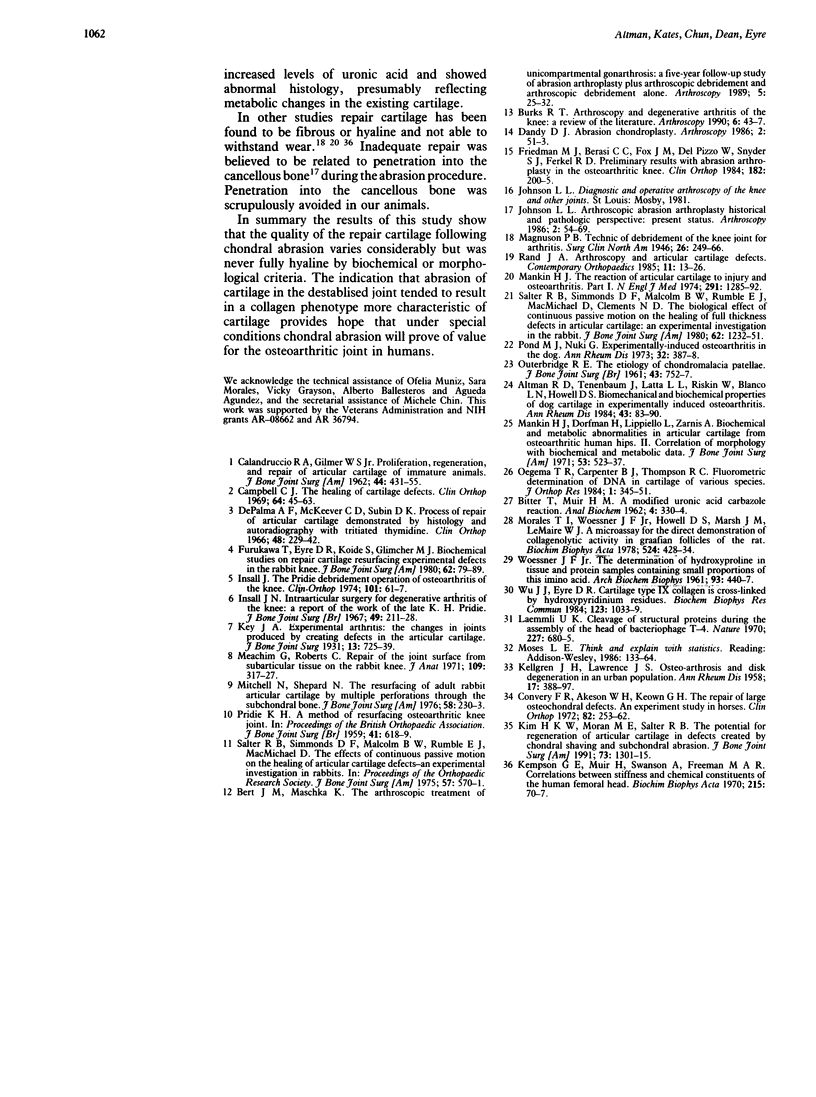
Images in this article
Selected References
These references are in PubMed. This may not be the complete list of references from this article.
- Altman R. D., Tenenbaum J., Latta L., Riskin W., Blanco L. N., Howell D. S. Biomechanical and biochemical properties of dog cartilage in experimentally induced osteoarthritis. Ann Rheum Dis. 1984 Feb;43(1):83–90. doi: 10.1136/ard.43.1.83. [DOI] [PMC free article] [PubMed] [Google Scholar]
- BITTER T., MUIR H. M. A modified uronic acid carbazole reaction. Anal Biochem. 1962 Oct;4:330–334. doi: 10.1016/0003-2697(62)90095-7. [DOI] [PubMed] [Google Scholar]
- Bert J. M., Maschka K. The arthroscopic treatment of unicompartmental gonarthrosis: a five-year follow-up study of abrasion arthroplasty plus arthroscopic debridement and arthroscopic debridement alone. Arthroscopy. 1989;5(1):25–32. doi: 10.1016/0749-8063(89)90086-8. [DOI] [PubMed] [Google Scholar]
- Burks R. T. Arthroscopy and degenerative arthritis of the knee: a review of the literature. Arthroscopy. 1990;6(1):43–47. doi: 10.1016/0749-8063(90)90096-v. [DOI] [PubMed] [Google Scholar]
- Convery F. R., Akeson W. H., Keown G. H. The repair of large osteochondral defects. An experimental study in horses. Clin Orthop Relat Res. 1972 Jan-Feb;82:253–262. [PubMed] [Google Scholar]
- Dandy D. J. Abrasion chondroplasty. Arthroscopy. 1986;2(1):51–53. doi: 10.1016/s0749-8063(86)80011-1. [DOI] [PubMed] [Google Scholar]
- DePalma A. F., McKeever C. D., Subin D. K. Process of repair of articular cartilage demonstrated by histology and autoradiography with tritiated thymidine. Clin Orthop Relat Res. 1966 Sep-Oct;48:229–242. [PubMed] [Google Scholar]
- Friedman M. J., Berasi C. C., Fox J. M., Del Pizzo W., Snyder S. J., Ferkel R. D. Preliminary results with abrasion arthroplasty in the osteoarthritic knee. Clin Orthop Relat Res. 1984 Jan-Feb;(182):200–205. [PubMed] [Google Scholar]
- Furukawa T., Eyre D. R., Koide S., Glimcher M. J. Biochemical studies on repair cartilage resurfacing experimental defects in the rabbit knee. J Bone Joint Surg Am. 1980 Jan;62(1):79–89. [PubMed] [Google Scholar]
- Insall J. N. Intra-articular surgery for degenerative arthritis of the knee. A report of the work of the late K. H. Pridie. J Bone Joint Surg Br. 1967 May;49(2):211–228. [PubMed] [Google Scholar]
- Insall J. The Pridie debridement operation for osteoarthritis of the knee. Clin Orthop Relat Res. 1974 Jun;(101):61–67. [PubMed] [Google Scholar]
- Johnson L. L. Arthroscopic abrasion arthroplasty historical and pathologic perspective: present status. Arthroscopy. 1986;2(1):54–69. doi: 10.1016/s0749-8063(86)80012-3. [DOI] [PubMed] [Google Scholar]
- KELLGREN J. H., LAWRENCE J. S. Osteo-arthrosis and disk degeneration in an urban population. Ann Rheum Dis. 1958 Dec;17(4):388–397. doi: 10.1136/ard.17.4.388. [DOI] [PMC free article] [PubMed] [Google Scholar]
- Kempson G. E., Muir H., Swanson S. A., Freeman M. A. Correlations between stiffness and the chemical constituents of cartilage on the human femoral head. Biochim Biophys Acta. 1970 Jul 21;215(1):70–77. doi: 10.1016/0304-4165(70)90388-0. [DOI] [PubMed] [Google Scholar]
- Kim H. K., Moran M. E., Salter R. B. The potential for regeneration of articular cartilage in defects created by chondral shaving and subchondral abrasion. An experimental investigation in rabbits. J Bone Joint Surg Am. 1991 Oct;73(9):1301–1315. [PubMed] [Google Scholar]
- Laemmli U. K. Cleavage of structural proteins during the assembly of the head of bacteriophage T4. Nature. 1970 Aug 15;227(5259):680–685. doi: 10.1038/227680a0. [DOI] [PubMed] [Google Scholar]
- Mankin H. J., Dorfman H., Lippiello L., Zarins A. Biochemical and metabolic abnormalities in articular cartilage from osteo-arthritic human hips. II. Correlation of morphology with biochemical and metabolic data. J Bone Joint Surg Am. 1971 Apr;53(3):523–537. [PubMed] [Google Scholar]
- Mankin H. J. The reaction of articular cartilage to injury and osteoarthritis (first of two parts). N Engl J Med. 1974 Dec 12;291(24):1285–1292. doi: 10.1056/NEJM197412122912406. [DOI] [PubMed] [Google Scholar]
- Meachim G., Roberts C. Repair of the joint surface from subarticular tissue in the rabbit knee. J Anat. 1971 Jul;109(Pt 2):317–327. [PMC free article] [PubMed] [Google Scholar]
- Mitchell N., Shepard N. The resurfacing of adult rabbit articular cartilage by multiple perforations through the subchondral bone. J Bone Joint Surg Am. 1976 Mar;58(2):230–233. [PubMed] [Google Scholar]
- Morales T. I., Woessner J. F., Howell D. S., Marsh J. M., LeMaire W. J. A microassay for the direct demonstration of collagenolytic activity in Graafian follicles of the rat. Biochim Biophys Acta. 1978 Jun 9;524(2):428–434. doi: 10.1016/0005-2744(78)90180-8. [DOI] [PubMed] [Google Scholar]
- OUTERBRIDGE R. E. The etiology of chondromalacia patellae. J Bone Joint Surg Br. 1961 Nov;43-B:752–757. doi: 10.1302/0301-620X.43B4.752. [DOI] [PubMed] [Google Scholar]
- Oegema T. R., Jr, Carpenter B. J., Thompson R. C., Jr Fluorometric determination of DNA in cartilage of various species. J Orthop Res. 1984;1(4):345–351. doi: 10.1002/jor.1100010402. [DOI] [PubMed] [Google Scholar]
- Pond M. J., Nuki G. Experimentally-induced osteoarthritis in the dog. Ann Rheum Dis. 1973 Jul;32(4):387–388. doi: 10.1136/ard.32.4.387. [DOI] [PMC free article] [PubMed] [Google Scholar]
- Salter R. B., Simmonds D. F., Malcolm B. W., Rumble E. J., MacMichael D., Clements N. D. The biological effect of continuous passive motion on the healing of full-thickness defects in articular cartilage. An experimental investigation in the rabbit. J Bone Joint Surg Am. 1980 Dec;62(8):1232–1251. [PubMed] [Google Scholar]
- WOESSNER J. F., Jr The determination of hydroxyproline in tissue and protein samples containing small proportions of this imino acid. Arch Biochem Biophys. 1961 May;93:440–447. doi: 10.1016/0003-9861(61)90291-0. [DOI] [PubMed] [Google Scholar]
- Wu J. J., Eyre D. R. Cartilage type IX collagen is cross-linked by hydroxypyridinium residues. Biochem Biophys Res Commun. 1984 Sep 28;123(3):1033–1039. doi: 10.1016/s0006-291x(84)80237-5. [DOI] [PubMed] [Google Scholar]







